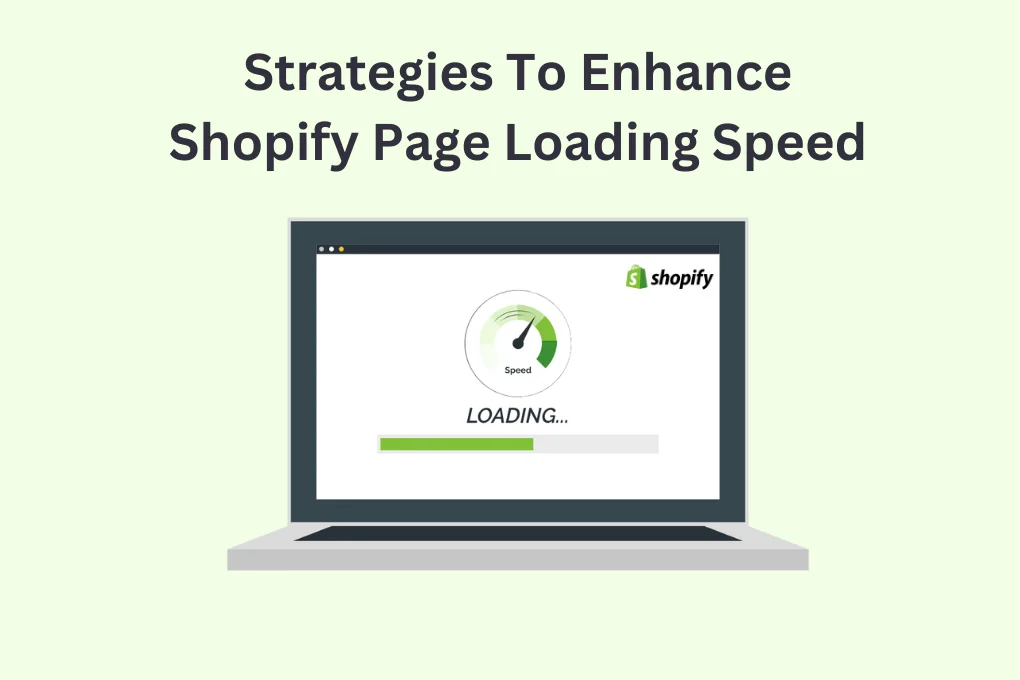Introduction
Shopify is an e-commerce platform that helps brands create, build, design, and develop their store on it. Shopify is known for its best features that enhance its reach. Shopify is best for customizing stores on it. With Shopify, you can easily boost your presence as it provides tools for SEO, speed, design, and development.
But the store is nothing worth without a fast loading speed. The website loading speed is when a website loads fully on the user’s browser. Thus, page speed optimization is a way to improve the website loading time instantly. This can be done by doing multiple things, such as compressing files, optimizing content, and more.
Therefore, Shopify speed optimization is crucial for your store’s success. So, in this blog, we will explore the multiple Shopify speed optimization techniques that are trending. First, let’s start with the factors that affect the store’s speed.

Want to read this blog offline?
No worries, download the PDF version
now and enjoy your reading later…
 Download PDF
Download PDF
Things That Slow Down Shopify Website Loading Speed
These are the elements that affect the store’s page space.
Store theme:
The theme is the foremost important element of any e-commerce store. It is the only thing that decides whether users will stay on your site or not. Choose a responsive theme for your store, as it will be helpful for your website’s loading speed. Thus, choose a lightweight theme that is easy to load on a user’s browser.
Excessive Apps And Plugins:
Each store needs multiple apps for different functionalities, like some for sales and inventory and others for social media marketing, product listing, etc. However, each store has its limit to contain the weight of the apps. Therefore, removing and deleting all the apps or plugins you don’t need much anymore is crucial. It will be helpful in boosting your store speed.
Too Many HTTP Requests:
If your Shopify store has numerous HTTP requests, it will definitely get slow, and a delay in loading speed leads to slow conversion. Therefore, minimize the number of HTTP requests your Shopify website gets.
Unoptimized Visuals:
Visuals on your website create a big difference in terms of attracting consumers. Thus, unoptimized images always impact website loading speed. So, you have to remove all the unrequired and unoptimized images from your store to improve its loading speed and, additionally, compress them.
Shopify Infrsture:
Shopify’s infrastructure shows you real-time details about your store’s performance. It provides information about the delays in various store activities and overall performance. Thus, you can check the Shopify status to know its real-time performance.
These are some of the factors that affect or hurt website loading time. Also, your site’s hosting provider and many more cause slow page speed. Now, we will move toward Shopify speed optimization to enhance your store loading speed.
How Do You Improve Shopify Store Loading Speed In Seconds?
Certainly, these are the tips to boost e-commerce website loading speed.
Get Lightning-Fast Pages: Start Now!
Boost Shopify Store NowReduce the use of third-party apps:
The more third-party apps you download on your store, the more delay you will experience in your website’s loading time. Thus, reduce the use of Hopify third-party apps and plugins.
Additionally, you can use the Minify app that combines all the scripts of your e-commerce store apps. With this, you can boost your store’s loading speed and make it faster than ever before.
Lightweight Template And Design:
Your Shopify website design matters a lot. Using a lightweight theme boosts your store learning speed due to fewer scripts. Use templates that don’t have multiple features and are easy to load. Also, the Shopify theme must be beautiful and easy to navigate.
Check Apps That Affects Your Site Speed:
You must install many apps in your Shopify store for numerous reasons. But many hamper your website performance; thus, it’s important to delete all the apps that affect your site speed.
But each program you get will make your store heavier overall. It implies that you should exercise caution when it comes to the quantity of apps you use. If an app doesn’t bring significant value to your store, it’s probably best to remove it from your website. For this, check which apps you don’t use much; additionally, add lightweight apps.
Compress Your Shopify Store Images:
Reduce the size of your store images to make them load faster. Compress the visuals of your store. Also, reduce the large-size images that significantly impact your store speed, and add the small ones. You can use tools like Tinypng and Bulk image edit that allow you to compress and minimize your store’s images.
Add CDN:
Content delivery networks store your website content and load it from the server near the user’s network. CDN is a network so severe that it is scattered around the world and helps websites load their content instantly without covering the path between the users’ browsers and the websites.
It is good news for you that Shopify provides a world-class CDN to its customers. So, you can get the benefit of it and experience an upgrade in your store’s loading speed.
Select The Optimized Font:
When it comes to Shopify, you must have to optimize its fonts. Shopify has a library that contains numerous fonts, and you have to choose the best one that suits your needs.
There are three primary families of system fonts available in Shopify: serif, sans-serif, and mono. With any of these families, you may still employ font styles like bold or italic. The operating system of your customer’s computer will determine which font really appears on it.
It’s important to adjust the font size sensibly to make it readable and suitable for the material on your website. Use large font sizes cautiously since they might cause your website to load more slowly.
Utilize AMP:
Make your online store faster for mobile shoppers with AMP, a tech that speeds up your site. For Shopify, ask a coder to add AMP through the admin panel. If coding is tricky, try apps like AMP Sheriff for a quick solution. Better site speed means happier mobile customers in the age of online shopping.
Use Google Tag Manager:
To gather information about visitors to your Shopify store and boost conversions, you will need data tools. However, using too many codes can slow down your site. Google Tag Manager helps. It combines all tracking tags into one JavaScript request.
So, with just one code snippet, you manage various store tags and get insights into your Google account. It’s a simpler way to enhance store performance and analytics.
Reduce Redirects And Broken Links:
A redirect is like a sign telling your web browser to go to a different page. A broken link is a link that leads to a missing file. These things can make your Shopify store slow.
To fix it, don’t use extra redirects; only send users where needed. Also, check all links to make sure none are broken. Keep your website smooth by avoiding unnecessary redirects and fixing broken links.
Thus, these are the strategies to improve Shopify store loading speed.
Conclusion
Therefore, in this blog, we have explained the basics of the Shopify platform and Shopify speed optimization. Additionally, we discussed multiple speed enhancement techniques. You can use website speed optimization tool, Website Speedy which is a great choice for optimizing your website speed.
A SaaS-based tool for speed optimization is called Website Speedy. The goal of Website Speedy is to reduce an eCommerce company’s loading time to a few seconds. On their website, you may confirm the legitimacy and effectiveness of this tool by looking through the case study and customer reviews.
November 27, 2023
Leave a Comment


































